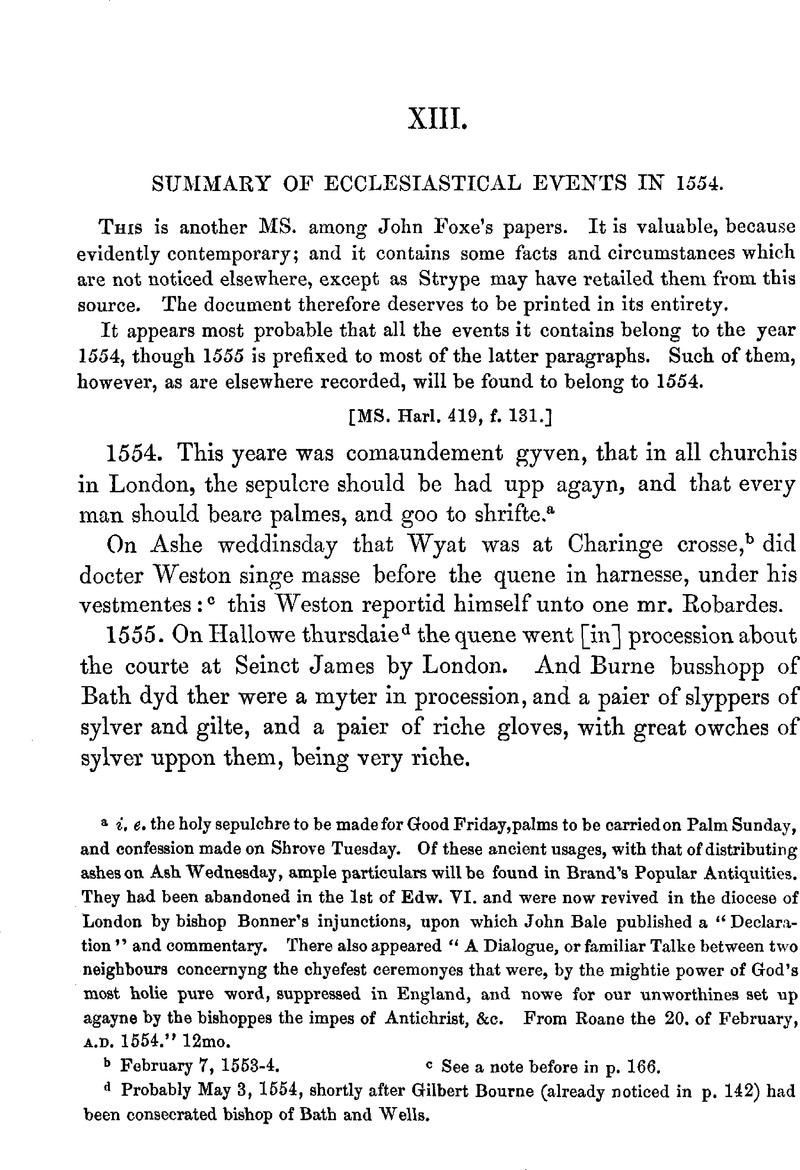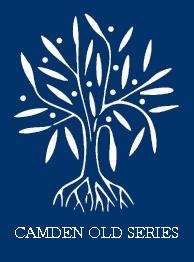No CrossRef data available.
Article contents
XIII. Summary of Ecclesiastical Events in 1554
Published online by Cambridge University Press: 23 February 2010
Abstract

- Type
- Narratives of the Days of the Reformation
- Information
- Copyright
- Copyright © Royal Historical Society 1859
References
page 287 note a i. e. the holy sepulchre to be made for Good Friday, palms to be carriedon Palm Sunday, and confession made on Shrove Tuesday. Of these ancient usages, with that of distributing ashes on Ash Wednesday, ample particulars will be found in Brand's Popular Antiquities. They had been abandoned in the 1st of Edw. VI. and were now revived in the diocese of London by bishop Bonner's injunctions, upon which John Bale published a “;Declaration”; and commentary. There also appeared “A Dialogue, or familiar Talke between two neighbours concernyng the chyefest ceremonyes that were, by the mightie power of God's most holie pure word, suppressed in England, and nowe for our unworthines set up agayne by the bishoppes the impes of Antichrist, &c. From Eoane the 20. of February, A.D. 1554.”; 12mo.
page 287 note b February 7, 1553–4.
page 287 note c See a note before in p. 166.
page 287 note d Probably May 3, 1554, shortly after Gilbert Bourne (already noticed in p. 142) had been consecrated bishop of Bath and Wells.
page 288 note a Certainly 1554. See the Chronicle of Queen Jane and Queen Mary, p. 76, and Machyn's Diary, p. 63.
page 288 note b The apostles' mass was one of the three masses which were daily performed by the minor canons of St. Paul's cathedral—Missa Beats? Mariae, Missa Apostolorum, Missa Capitularum. (Consuetudines Eccl. S. Pauli Lond., printed in Dugdale's History of St. Paul's, edit. Ellis, p. 353.) It appears to have derived its name from having been performed at the apostles' altar, (Ibid. edit. Ellis, p. 333,) and had been stopped in 1549. By a letter addressed to bishop Bonner dated the 24th June in that year, the council, “having very credible notice that within your cathedral church there be as yet the Apostles masse and our Ladies masse and other masses of such peculiar name, under the defence and nomination of our Ladies communion and the Apostles communion, used in private chappels and other remote places of the same and not in the chauncell, contrary to the King's majesties proceedings,” 's letter written on the 26th, forwarding the same to the dean and chapter. This prohibition will be found noticed in the Chronicle of the Grey Friars of London, at p. 59, and at p. 88 its revival, under the misnomer of “the epestylle masse,” at the same date as in the text, “the ij day of Aprille,” 1554, not 1555. Machyn, in his Diary, under the sameyear, says “The xxx. day of Aprell begun the postyll mass at Powles at the v. of the cloke in the mornyng overe day:” which means, perhaps, that during the summer months the mass was at an earlier hour than in the winter. Again, after the accession of Elizabeth, Machyn says, “The xxx day of September (1559) begane the mornyng [prayer] at Poulles at that owr (i.e. at the same hour) as the postylles masse.” The Rev. Dr. Kock (who obligingly answered an inquiry of mine on this subject, in Notes and Queries, 2nd series, vol. v. p. 297,) suggests that the ritual used for this mass was probably that to be found both in the Roman and Salisbury missals for June 29; on which day of the month, though not in the same year, St. Peter and St. Paul suffered martyrdom at Rome.
page 288 note c This date, again, should be 1554.
page 289 note a See other versions of this story in the Chronicle of Queen Jane and Queen Mary, p. 78.
page 289 note b Nov. 4, 1554. See another account of this ceremony in the Chronicle of the Grey Friars of London, p. 92: and a third in Machyn's Diary, p. 73. The priests were some of those who were now compelled to relinquish their wives. Strype, Memorials of Cranmer, p. 326, has given a list of those priests in the diocese of London who were called to account on this head, and specifies those who performed the required penance.
page 289 note c Also 1554: see Machyn's Diary, p. 76.
page 289 note d The tenure in an earldom or barony possessed by the husband of an heiress was considered to be confirmed by the birth of a child, before which it was incomplete. The passage in the text is suggested by the application of this doctrine to the crown. Had king Philip been crowned he would have continued king of England after queen Mary's death.
page 289 note e Cardinal Pole. His oration is given at full in John Elder's letter, reprinted in the Chronicle of Queen Jane and Queen Mary, p. 154.
page 290 note a Mead absolution.
page 290 note b The circumstance that there was one member of the lower house of parliament that ventured to open his mouth at this crisis, is mentioned, but without naming him, by bishop Gardyner, in the course of his examination of the martyr John Rogers, on the 22nd Jan. 1554–5. On that occasion Gardyner (then lord chancellor) said to Rogers: “Ye have heard of my lord cardinal's (Pole) commyng, and that the parliament hath receyved his blessing, not one resisting unto it, but one man which did speahe against it. Such a unitie, and such a myracle, hath not been seen. And all they, of which there are eyght score in one house, save (1) one that was by, whose name I know not, have with one assent receyved pardon of their offences, for the schism that we have had in England, in refnsing the holy father of Rome to be head of the Catholicke Church.” (Foxe.)
(1) This word has been misprinted “said” in all the editions of Foxe before the last; but it was pointed out to be an error for “save” in the errata to the first edition of 1563.
page 290 note c Sir Ralph Bagenal was evidently an extraordinary personage in his day. The editor of the last edition of Foxe, (1846, vi. 776,) has termed him “this noble-minded individual” in reference to the passage in Strype (Memorials, iii. 204,) derived from the statement in the text: but, from what we elsewhere find of him, he was more probably a reckless dissolute courtier, who chose to adopt the Protestant party, and, having but little to lose, did not stop short, from any scruples of sobriety or caution, in doing or saying whatever the impulse of the moment dictated. Underbill in a passage already printed (p. 158) has classed him with the gamblers and “ruffling roysters” of the reign of Henry VIII. His name occurs as one of the defenders in the justs hoiden on the morrow of king Edward's coronation Feb. 21, 1546–7. In 6 Edw. VI. he obtained a grant of Dieulacres abbey in Staffordshire, with various dependent manors, as thus related by Sampson Erdeswick: “The said house, with the most things belonging to it, was given, in king Edward the Sixth's time, to sir Raufe Bagenholt, for his advancement. But sir Raufe (good-fellow like) dispersed it el deditpavperibus, for he sold it to the tenants, for the most part to every man his own, at so reasonable a rate, that they were well able to perform the purchase thereof, and [he] spent the money he received, gentleman-like, leaving his son sir Samuel Bagenhall (now lately knighted at Cales, anno 1596) to advance himself by his valour, as he had done before.” (Survey of Staffordshire, edit. 1844, p. 493.) The same author, when treating of the village of Bagenhall, had previously (p. 15) thus noticed the family, after stating that they occurred in records of the time of Henry III.: “but since then all the names of them have been brought down, I know not how, unto the plebeian estate, until this our present age, that two brethren of that surname, sons of John Bagenhall, born at Barleston [other copies say Newcastle], the one Ralfe, the other Nicholas, were for their valour, Raufe at Musselborough [1551] and Nicholas in Ireland [1565] both of them adorned with the honour of knighthood; the son of which sir Nicholas, Henry by name, tracing his father's steps, is also advanced to the same dignity [1578], as was also Samuel the son of Ralph, knighted for his military services [as in the preceding paragraph].” It does not appear for what place sir Ralph was sitting at the time of his memorable speech in parliament; but in 1 Eliz. he represented the county of Stafford, his brother sir Nicholas then sitting for Newcastle-under-Lyme. In 5 Eliz. sir Ralph sat for Newcastle, in 13 Eliz. sir John [qu. sir Ralph again ?] Sir Ralph was sheriff of Staffordshire in 2 Eliz. His name occurs so late as 1572 as being one of the commissioners for concealed lands, whose conduct (according to Strype) had become “so odions, so unjust, and so oppressive, that, by the lord treasurer's means, the queen by proclamation revoked her commission, and forced them to restore the things they had wrongfully taken. But they stood upon their justification, and laboured again to get their commission renewed: and particularly one sir Richard [read Ralph] Bagnal did so, who was very severe, especially upon the clergy, being also in commission (either with George Delves and Lancelot Bostock esquires, or concurrently with them,) to compound for offences against the statute of non-residence, and other offences of the clergy, and to take the whole commodity thence arising.” (See Strype's Annals, ii. 313, and his Life of Archbishop Parker, book iv. chapters 21 and 42; also Archbishop Parker's Correspondence, printed for the Parker Society, pp. 413, 424.) Sir Ralph Bagenal's arms were Sable, within an orle of martlets argent an inescocjieon ermine charged with a leopard's face gules; and his crest, On a wreath or and sable a dragon's head erased gules charged with two bars or. (MS. Cotton. Claudius, C. in.) Sir Nicholas Bagenal above mentioned occurs as marshal of Ireland, 28 Jan. 1550–1. (Privy-council register.)
In Ward's History of Stoke-upon-Trent, 1843, 8vo., p. 346, there is a pedigree of this family, extending from William Bagenhall of Newcastle-under-Lyme, 1 Edw. IV. (the great-grandfather of sir Ralph) to Anna-Maria and Frances the daughters and coheirs of John Bagnall esq. of Early Court, Berks, who were married respectively to William Scott, Lord Stowell, and the Hon. Thomas Windsor.


